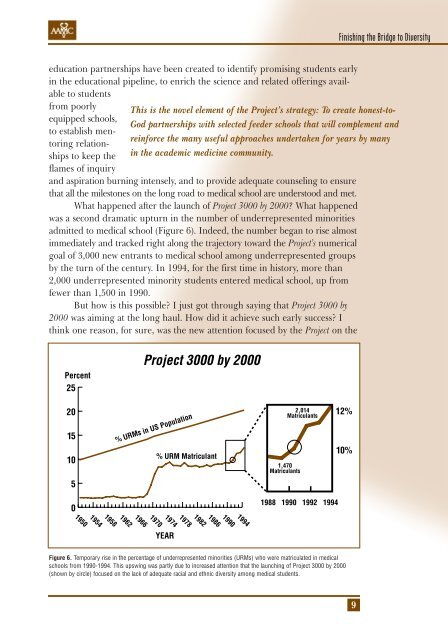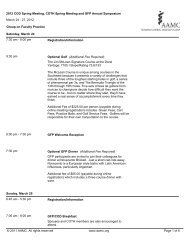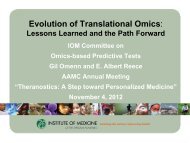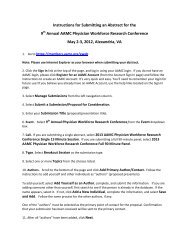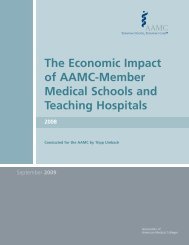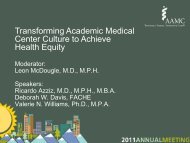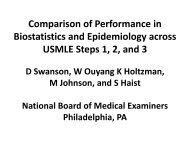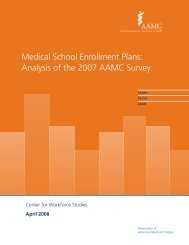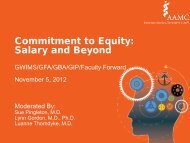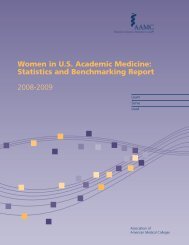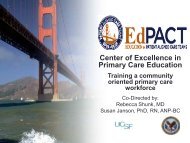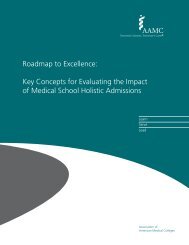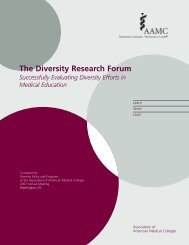Finishing the Bridge to Diversity - Member Profile - AAMC
Finishing the Bridge to Diversity - Member Profile - AAMC
Finishing the Bridge to Diversity - Member Profile - AAMC
Create successful ePaper yourself
Turn your PDF publications into a flip-book with our unique Google optimized e-Paper software.
<strong>Finishing</strong> <strong>the</strong> <strong>Bridge</strong> <strong>to</strong> <strong>Diversity</strong><br />
education partnerships have been created <strong>to</strong> identify promising students early<br />
in <strong>the</strong> educational pipeline, <strong>to</strong> enrich <strong>the</strong> science and related offerings available<br />
<strong>to</strong> students<br />
from poorly This is <strong>the</strong> novel element of <strong>the</strong> Project’s strategy: To create honest-<strong>to</strong>equipped<br />
schools,<br />
God partnerships with selected feeder schools that will complement and<br />
<strong>to</strong> establish men<strong>to</strong>ring<br />
relation-<br />
reinforce <strong>the</strong> many useful approaches undertaken for years by many<br />
ships <strong>to</strong> keep <strong>the</strong> in <strong>the</strong> academic medicine community.<br />
flames of inquiry<br />
and aspiration burning intensely, and <strong>to</strong> provide adequate counseling <strong>to</strong> ensure<br />
that all <strong>the</strong> miles<strong>to</strong>nes on <strong>the</strong> long road <strong>to</strong> medical school are unders<strong>to</strong>od and met.<br />
What happened after <strong>the</strong> launch of Project 3000 by 2000 What happened<br />
was a second dramatic upturn in <strong>the</strong> number of underrepresented minorities<br />
admitted <strong>to</strong> medical school (Figure 6). Indeed, <strong>the</strong> number began <strong>to</strong> rise almost<br />
immediately and tracked right along <strong>the</strong> trajec<strong>to</strong>ry <strong>to</strong>ward <strong>the</strong> Project’s numerical<br />
goal of 3,000 new entrants <strong>to</strong> medical school among underrepresented groups<br />
by <strong>the</strong> turn of <strong>the</strong> century. In 1994, for <strong>the</strong> first time in his<strong>to</strong>ry, more than<br />
2,000 underrepresented minority students entered medical school, up from<br />
fewer than 1,500 in 1990.<br />
But how is this possible I just got through saying that Project 3000 by<br />
2000 was aiming at <strong>the</strong> long haul. How did it achieve such early success I<br />
think one reason, for sure, was <strong>the</strong> new attention focused by <strong>the</strong> Project on <strong>the</strong><br />
Percent<br />
25<br />
Project 3000 by 2000<br />
20<br />
15<br />
10<br />
% URMs in US Population<br />
% URM Matriculant<br />
1,470<br />
Matriculants<br />
2,014<br />
Matriculants<br />
12%<br />
10%<br />
5<br />
0<br />
1988 1990 1992 1994<br />
YEAR<br />
1970<br />
1966<br />
1962<br />
1958<br />
1954<br />
1950<br />
1994<br />
1990<br />
1986<br />
1982<br />
1978<br />
1974<br />
Figure 6. Temporary rise in <strong>the</strong> percentage of underrepresented minorities (URMs) who were matriculated in medical<br />
schools from 1990-1994. This upswing was partly due <strong>to</strong> increased attention that <strong>the</strong> launching of Project 3000 by 2000<br />
(shown by circle) focused on <strong>the</strong> lack of adequate racial and ethnic diversity among medical students.<br />
9


